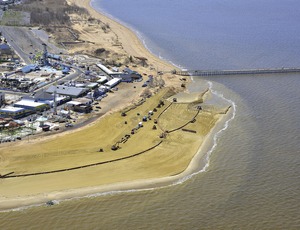By many accounts, the perception is that federal, state and local relief funds in the wake of Superstorm Sandy have been much too slow to trickle down to the people and projects that need them. To be sure, there are signs of significant progress in New York and New Jersey—the states hardest hit by the October 2012 storm. Huge debris piles are gone; major infrastructure was repaired; many devastated homes torn down, repaired and/or elevated; and innovative ideas realized to prevent or withstand the next storm's damage But for thousands of storm victims and many projects, government reimbursement checks are held up or still await approval 19 months after Congress passed relief funding legislation.

The process has been a nightmare for many. "Originally, you couldn't apply for some of the grants unless you applied for a loan and were rejected first," says Phyllis Salowe-Kaye, executive director of New Jersey Citizen Action, the state's largest citizen watchdog group, which works with individuals and small businesses. "There've been so many problems … and a total lack of transparency in this administration in who applied for the loans, what the resolutions were—and lost paperwork."
Mike Elmendorf, president and CEO of the Associated General Contractors of New York State, says government's slow pace of getting funding to victims and to state and local officials running relief programs is unfortunate but not surprising. "When you're dealing with something like this, something this massive, [the governmental response] is never enough, so the criticisms are natural," he says.
Frustrations aside, industry executives acknowledge the significant progress made in many of the extensive rebuilding programs well under way. These include nearly $2.8 billion of shoreline resiliency projects, part of the U.S. Army Corps of Engineers' Sandy program.
Elmendorf says his membership is awaiting word from the New York State Dept. of Environmental Conservation (DEC) on a "significant amount" of Sandy redundancy and infrastructure hardening work that is expected soon. He says he cannot offer a time line, however, as the agency is awaiting federal funding approval for the work to begin.
Since January 2013, when, after a long and contentious debate, Congress approved what ultimately became a $47.9-billion Sandy relief package, victims of the storm as well as contracting community members have asked the same question: Where is this money?
That question will likely continue to be asked until the total relief package is funneled from federal agencies through state and local governments and programs to storm victims.
The funnel begins with the Disaster Relief Appropriations Act of 2013, or the Sandy supplemental legislation, which distributes the funds to 19 federal agencies to help rebuild homes, businesses, transportation and other infrastructure. Congress had initially approved $50.5 billion, but sequestration slashed that by 5% to the present total. In addition, nearly $10 billion was approved for the federal flood insurance program.
The Federal Emergency Management Agency (FEMA) provides grants to 13 states to reimburse them for infrastructure and resiliency work, and also provides assistance to individuals and small businesses for recovery efforts. The Dept. of Housing and Urban Development (HUD) awards grants to states and regions with approved plans on how the funding will be spent. States and local governments also provide grants, loans and programs for homeowners, businesses and projects. FEMA, HUD and the U.S. Dept. of Transportation were allotted the largest shares of Sandy funding (see table, below).
The funds have been released through installments and, as of early August, federal agencies awarded New Jersey a total of $4.85 billion and New York a total of $8.7 billion, according to each state's Sandy recovery website.
But, in many cases, snafus have held up the process of getting funds to storm victims and projects, critics say. The city of New Rochelle, N.Y., which only recently was awarded $1.8 million for repairs to its significantly damaged Hudson Park marina infrastructure, is a case in point. FEMA, which told New Rochelle officials immediately after the storm that the project was eligible for 90% federal reimbursement, later changed course. Contending that the damage was not caused by the storm, agency officials informed the city that the project was ineligible for the funding, said U.S. Sen. Charles Schumer (D) in a statement last July.
That declaration forced the city "to resubmit its application for funding, with new forms of evidence, at multiple points over the past year, which forced the city to incur additional expenses and project delays," said Schumer, who joined other New York lawmakers and officials to press FEMA to reverse its decision. With the lack of certainty on funds, repairs on the $3.96-million project are less than 10% complete, he said. The city has already outlaid about $1 million for the project, expecting FEMA reimbursement, and cannot afford any additional outlays at this point, Schumer added.
Process Flow
HUD is using Community Development Block Grants to disburse its $15.2 billion in Sandy aid to individuals and businesses. It released its third and final grants tranche, totaling more than $2.5 billion, to New York state, New York City, New Jersey, Connecticut and Rhode Island in May. This brought the agency's total funding for communities to more than $13 billion, with a further $930 million earmarked as seed money for the six winning proposals in its Rebuild by Design competition.
Allocation of the last tranche, however, drew perhaps the strongest criticism when President Obama announced a national resiliency competition last June using about $820 million from the block grant program's Sandy package. The contest is open to any state or local government impacted by a major disaster in 2011, 2012 and 2013.
"In some parts of the country, weather-related disasters like droughts and fires and storms and floods are going to get harsher and they're going to get costlier," Obama said in a commencement address at the University of California, Irvine. "That's why today I'm announcing a new $1-billion competitive fund to help communities prepare for the impacts of climate change and build more resilient infrastructure across the country."
The announcement immediately drew ire from local lawmakers who expressed outrage that the money would be diverted from the Sandy package. In a joint statement in June, New Jersey state Sens. Joe Kyrillos (R-Monmouth) and Jim Holzapfel (R-Ocean) condemned what they called the "Sandy Aid Sweepstakes." The federal government "continues to drop the ball on Sandy recovery," Holzapfel said. "First, we had to shame Congress into passing a disaster recovery package for Sandy victims after months of inaction. Now, President Obama has announced that HUD will divert $1 billion of Sandy aid away from New Jersey, while thousands of our home and business owners remain stuck in a mountain of federal red tape and are still in need of help. HUD should scrap that plan and spend every penny of Sandy aid where it is needed most, along the Jersey shore."
Kyrillos added that "remaining funding allocated by Congress for these very types of recovery needs is now being put up for grabs as a contest prize." He said New Jersey "has never gotten its fair share of Sandy aid funding, and we have never learned why New York state has received approximately twice as much money even though our losses are roughly the same. This funding should immediately be returned to those devastated by Sandy who need it most."
Elmendorf understands the frustration. "I don't think a recovery is ever fast enough, especially if you are someone who has had your life, your home, your community disrupted," he says. "To some extent the criticism is fair, but it's not unique to the Sandy effort.… If you went around the country and looked at any of the disasters that have occurred, I think it would be the same thing." He adds, "This is not easy stuff to navigate."



Post a comment to this article
Report Abusive Comment